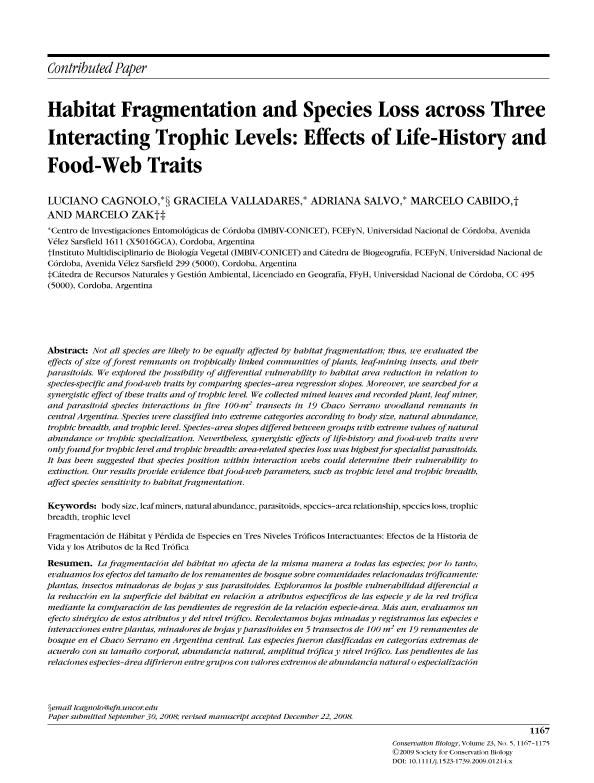Artículo
Habitat fragmentation and species loss across three interacting trophic levels: effects of life-history and food-web traits
Cagnolo, Luciano ; Valladares, Graciela Rosa
; Valladares, Graciela Rosa ; Salvo, Silvia Adriana
; Salvo, Silvia Adriana ; Cabido, Marcelo Ruben
; Cabido, Marcelo Ruben ; Zak, Marcelo Román
; Zak, Marcelo Román
 ; Valladares, Graciela Rosa
; Valladares, Graciela Rosa ; Salvo, Silvia Adriana
; Salvo, Silvia Adriana ; Cabido, Marcelo Ruben
; Cabido, Marcelo Ruben ; Zak, Marcelo Román
; Zak, Marcelo Román
Fecha de publicación:
06/2009
Editorial:
Wiley Blackwell Publishing, Inc
Revista:
Conservation Biology
ISSN:
0888-8892
e-ISSN:
1523-1739
Idioma:
Inglés
Tipo de recurso:
Artículo publicado
Clasificación temática:
Resumen
Not all species are likely to be equally affected by habitat fragmentation; thus, we evaluated theeffects of size of forest remnants on trophically linked communities of plants, leaf-mining insects, and theirparasitoids. We explored the possibility of differential vulnerability to habitat area reduction in relation tospecies-specific and food-web traits by comparing species-area regression slopes. Moreover, we searched for asynergistic effect of these traits and of trophic level. We collected mined leaves and recorded plant, leaf miner,and parasitoid species interactions in five 100-m2 transects in 19 Chaco Serrano woodland remnants in central Argentina. Species were classified into extreme categories according to body size, natural abundance,trophic breadth, and trophic level. Species?area slopes differed between groups with extreme values of natural abundance or trophic specialization. Nevertheless, synergistic effects of life-history and food-web traits were only found for trophic level and trophic breadth: area-related species loss was highest for specialist parasitoids.It has been suggested that species position within interaction webs could determine their vulnerability to extinction. Our results provide evidence that food-web parameters, such as trophic level and trophic breadth,affect species sensitivity to habitat fragmentation.
Archivos asociados
Licencia
Identificadores
Colecciones
Articulos(IMBIV)
Articulos de INST.MULTIDISCIPL.DE BIOLOGIA VEGETAL (P)
Articulos de INST.MULTIDISCIPL.DE BIOLOGIA VEGETAL (P)
Citación
Cagnolo, Luciano; Valladares, Graciela Rosa; Salvo, Silvia Adriana; Cabido, Marcelo Ruben; Zak, Marcelo Román; Habitat fragmentation and species loss across three interacting trophic levels: effects of life-history and food-web traits; Wiley Blackwell Publishing, Inc; Conservation Biology; 23; 5; 6-2009; 1167-1175
Compartir
Altmétricas



